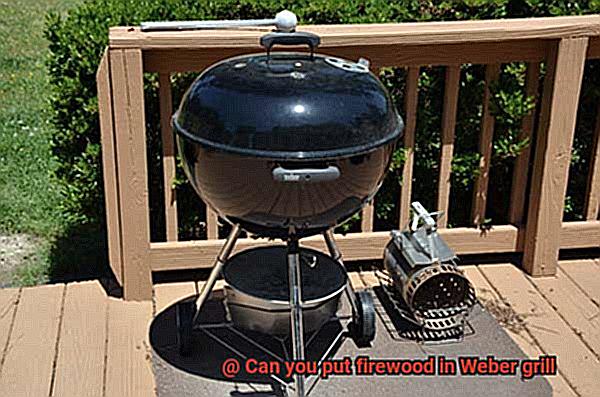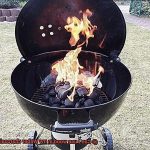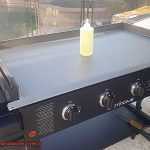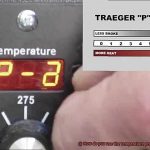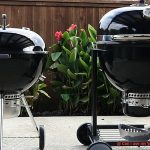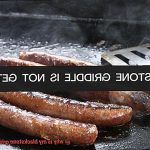Are you tired of the same old, bland cookouts? Do you crave that smoky flavor that only firewood can provide? Well, if you’re a grilling enthusiast, you might be wondering whether you can use firewood in your Weber grill. Lucky for you, we’ve got all the answers.
Grilling with firewood has become increasingly popular among outdoor chefs who want to add a unique flavor to their dishes and enjoy the satisfaction of cooking over an open flame. But before you start tossing logs into your Weber grill, it’s essential to know whether it’s designed for this type of fuel.
In this blog post, we’ll explore the question “Can you put firewood in Weber grill?” We’ll also discuss the benefits and drawbacks of using firewood as your grilling fuel, including its availability, cost, and maintenance requirements. Plus, we’ll share some tips on how to set up your Weber grill for firewood and adjust your cooking techniques for optimal results.
So if you’re ready to take your grilling game to the next level and impress your guests with delicious smoky flavors, keep reading. We’ve got everything you need to know about using firewood in a Weber grill right here.
Contents
Is it Possible to Put Firewood in a Weber Grill?
Yes, it’s possible, but there are a few important factors to consider before getting started.
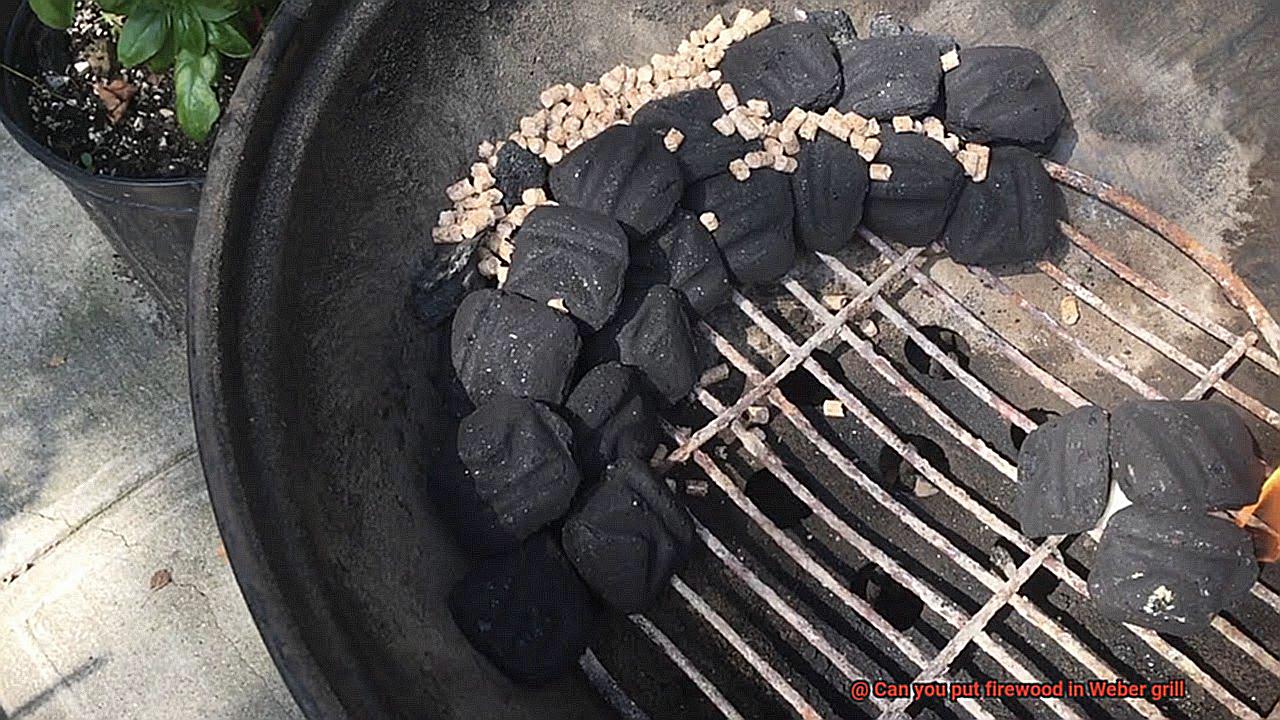
Firstly, ensure that your Weber grill is designed for cooking with wood. Certain models lack proper ventilation and can’t handle the weight of wood logs. Using wood in such grills can cause damage and even be dangerous. However, models like the Weber Kettle Grill or Weber Smokey Mountain Cooker are specifically designed to handle wood as a fuel source.
Once you confirm that your grill is suitable for wood cooking, choose the right type of wood. Hardwoods such as oak, hickory, and mesquite are great options because they burn cleanly and provide a delectable smoky flavor. Avoid softwoods such as pine or cedar since they contain resin that can give off an unpleasant taste and toxic fumes when burned.
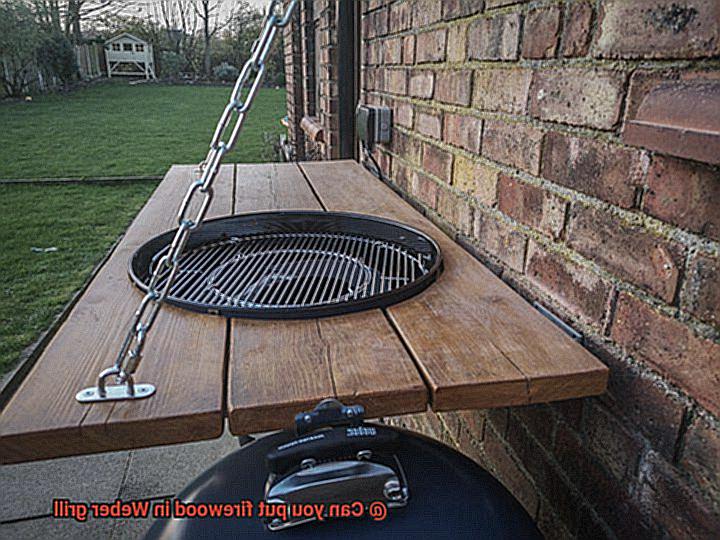
Before putting the firewood into the grill, prepare it properly. Clean the grates with a grill brush and remove any ash left from previous grilling sessions. Also, ensure proper ventilation to allow good airflow.
When building your fire, start small with a few pieces of kindling at the bottom of the grill and add larger logs as needed. Don’t overload the grill with too much wood at once as it can cause the fire to burn too hot and potentially damage your grill.
Throughout the grilling process, keep a close eye on the fire and adjust the airflow as necessary. This ensures that your food cooks evenly without getting too smoky or burnt.
Finally, practice safe grilling techniques. Stack the firewood securely and keep a fire extinguisher nearby in case of accidents.
Which Weber Grills Are Suitable for Burning Wood?
Before you begin, it’s crucial to ensure that you have the right Weber grill for the job. As an expert in this matter, let me guide you through which Weber grills are suitable for burning wood and take your grilling experience to new heights.
Firstly, it is essential to note that not all Weber grills are designed for wood-burning. Models like the Weber Original Kettle and Weber Master-Touch are meant to burn charcoal briquettes or lump charcoal, making them unsuitable for burning wood as the primary fuel source. However, they can still be used with wood chips or chunks to infuse your food with added flavor.
If you’re looking to grill with wood as the primary fuel source, then a Weber pellet grill is your best option. These grills, such as the Weber SmokeFire and Weber Summit Grill Center, offer precise temperature control and the ability to burn hardwood pellets for that distinct smoky flavor. They also have a large cooking surface area, perfect for cooking large cuts of meat or hosting backyard BBQs.
If you’re looking for a more impressive option to impress a crowd, consider the Weber Ranch Kettle. This behemoth of a grill boasts a massive 37.5-inch cooking grate and is designed to burn large logs of wood. While it may be one of the pricier options in Weber’s lineup, it’s perfect for cooking up a feast for your loved ones and taking your outdoor gatherings to the next level.
For those who prefer a more portable option for grilling with wood, the Weber Go-Anywhere Charcoal Grill is perfect. This compact grill can be used with small logs of wood and is ideal for camping trips or tailgating with friends and family.
What Type of Wood Should Be Used in a Weber Grill?
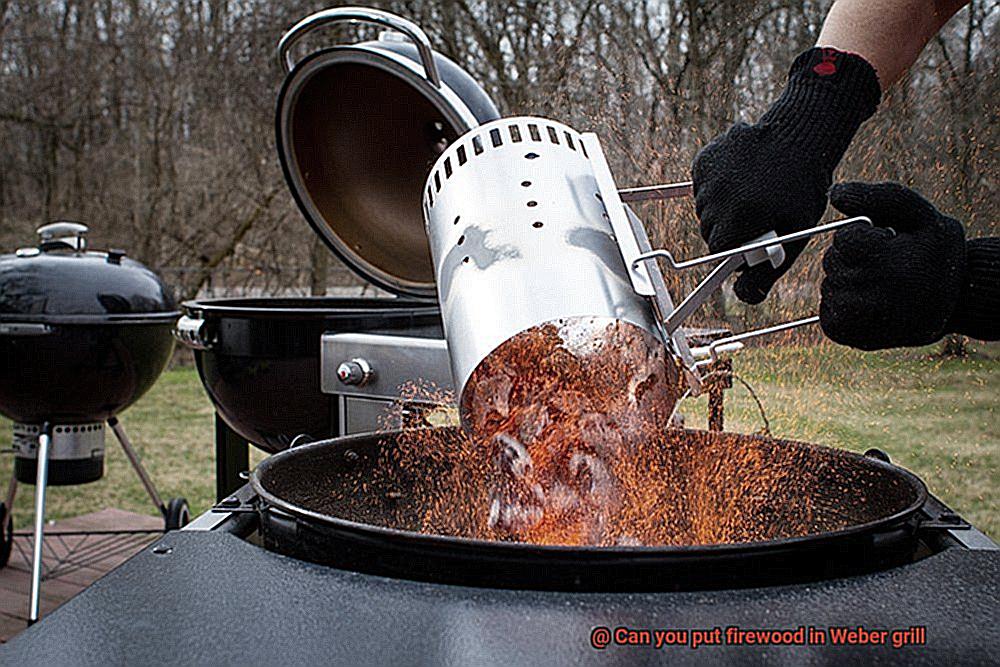
And let me tell you, the type of wood you choose can make all the difference in the flavor of your food. So, let’s dive into the world of wood and find out what works best for your Weber grill.
First up, we have hardwoods like hickory, mesquite, and oak. These woods are perfect for smoking meat and are known for their strong, smoky flavors. However, they can be a bit tricky to control and may create a hotter grill than desired. If you’re a seasoned griller and love bold flavors that pack a punch, hardwoods may be just what you need.
On the other hand, fruitwoods like apple and cherry are milder in flavor and provide a sweet, fruity taste to your food. They’re easier to control and maintain a lower temperature on your grill. If you’re new to grilling with wood or prefer a more subtle flavor, fruitwoods could be the perfect fit for you.
But wait, there’s more. For those who want to get really creative with their grilling flavors, consider using wood chips or chunks from wine barrels or whiskey barrels. These woods add hints of wine or whiskey flavors to your food and can take your grilling game to the next level.
Now here’s an important tip: avoid using softwoods like pine or cedar. These woods can create harmful smoke and chemicals when burned, which is definitely not what we want in our food.
Preparing the Grill for Burning Firewood
Burning firewood on your Weber grill can impart a signature smoky flavor to your dishes that simply can’t be achieved with traditional charcoal or gas grilling. But before you get started, it’s crucial to prepare your grill correctly for the best results.
First and foremost, give your grill a deep cleaning. Any leftover ash or debris can impact the quality of the firewood and make it burn unevenly. Use a grill brush to scrape off any residue, and then wipe it down with a damp cloth. Once your grill is spotless, it’s time to create a space for the firewood.
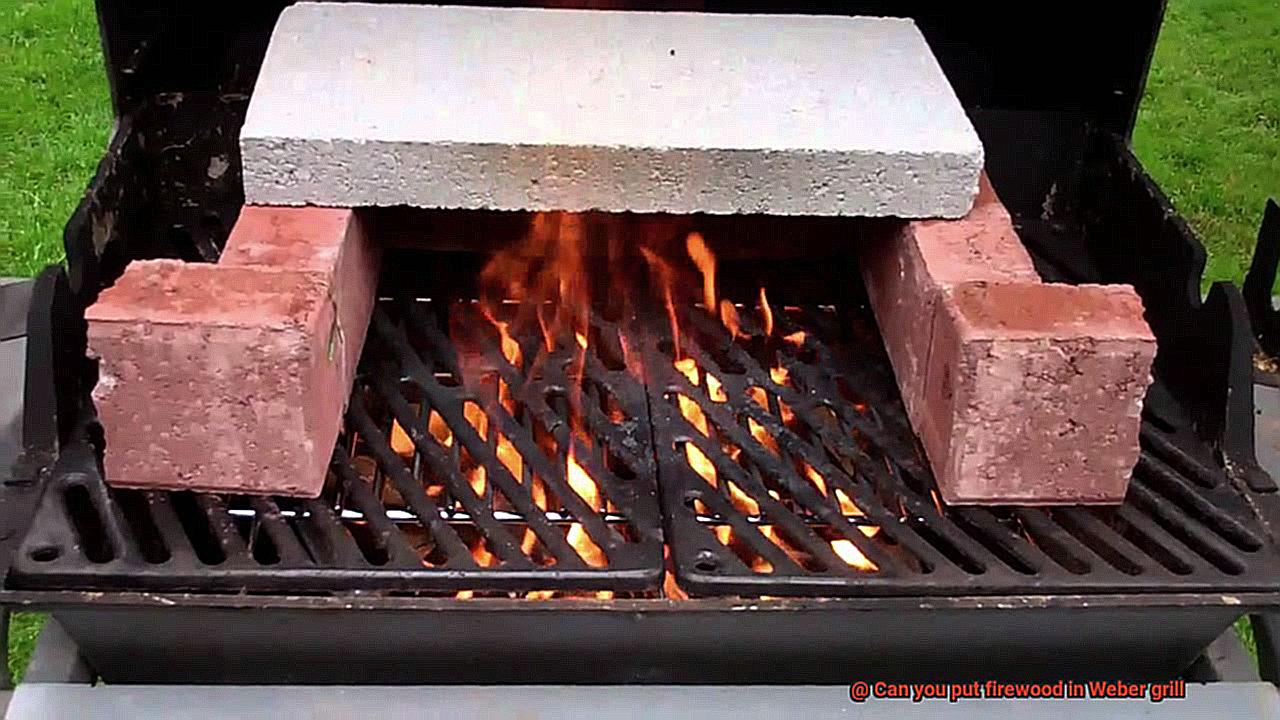
If your Weber grill has a charcoal tray, remove it, and place the firewood directly on the bottom grate. If not, place the firewood on top of a layer of charcoal. For optimal results, use dry hardwoods such as oak, hickory, or maple. These woods burn hotter and longer than softer woods like pine or cedar.
When you’re ready to light the firewood, you have two options: lighter fluid or a chimney starter. If using lighter fluid, make sure that you let it soak in for about 30 seconds before lighting it. If using a chimney starter, fill it with charcoal and light it from underneath. Once the charcoal is hot and glowing, carefully pour it over the firewood.
As soon as your firewood ignites, adjust the vents on your grill to control the temperature and airflow. Keep an eye on the firewood and add more as needed to maintain a consistent temperature throughout your cooking process. Don’t be afraid to experiment with different types of wood and cooking techniques until you find what works best for you.
Building the Fire in Your Weber Grill
Building the fire in your Weber grill is a crucial step in creating mouth-watering, smoky and flavorful dishes. So, let’s dive into the details and learn how to make the most out of your grill.
First things first, ensure that your grill is clean before starting. You don’t want any unpleasant leftover flavors ruining your dish. Once it’s clean, it’s time to choose your fuel. Charcoal briquettes are the most commonly used type of fuel in Weber grills, providing a consistent heat source. However, don’t forget about wood chips and chunks for added flavor.
When building your fire, start with a handful of crumpled newspaper at the bottom of the grill. Then, stack your charcoal briquettes into a pyramid shape on top of the newspaper. Light the newspaper and let the briquettes burn until they are covered in white ash.
Now it’s time to add some flavor. Wood chips and chunks come in a variety of flavors such as hickory, mesquite, applewood, and cherry. Soak them in water for at least 30 minutes before adding them to the fire. This will prevent them from burning too quickly and producing too much smoke. Spread them out evenly over the top of the hot coals and close the lid of the grill.
Remember to control the temperature and airflow using vents to achieve optimal results. Experiment with different types of wood and cooking techniques to find what works best for you. The possibilities are endless; you can create unique smoky flavors by mixing different wood chips or chunks.
Monitoring and Adjusting the Fire as Needed
If you’re using firewood in your Weber grill, get ready for a flavor explosion. However, mastering the art of grilling with firewood involves monitoring and adjusting the fire as needed. Here are some tips to help you perfect your grilling game.
Temperature is key. Keep an eye on the temperature gauge on the lid of your grill to ensure it stays within your desired range. If it starts to get too high, adjust the vents to let out some of the heat. Conversely, if it drops too low, add more wood and adjust the vents to increase airflow.
When it comes to adding wood, less is more. Adding too much at once can cause sudden temperature spikes that can be hard to control. Instead, add small amounts of wood gradually, waiting for each addition to ignite fully before adding more. This will help you maintain a steady temperature throughout the cooking process.
It’s also important to choose the right type of wood for your desired cooking style. For example, hardwoods like oak and hickory produce a hotter fire with less smoke. Meanwhile, softer woods like cherry and apple produce a cooler fire with more smoke. Experiment with different types of wood to create unique flavors that’ll leave your guests wanting more.
4D25NoMzWX4″ >
Conclusion
In conclusion, grilling with firewood has become the latest trend among outdoor cooking enthusiasts who crave a unique flavor and the satisfaction of cooking over an open flame. However, before you start tossing logs into your Weber grill, it’s crucial to determine whether it can handle this type of fuel. Certain models lack proper ventilation and structural support to accommodate wood logs, which can cause damage or even pose safety hazards.
Fortunately, Weber offers models like the Kettle Grill and Smokey Mountain Cooker that are specifically designed to handle firewood as a fuel source. Once you confirm that your grill is suitable for wood cooking, choose the right hardwoods such as oak, hickory, or mesquite that burn cleanly and provide a delectable smoky flavor.
Before putting the firewood into the grill, prepare it properly by cleaning the grates with a grill brush and removing any ash left from previous grilling sessions. Also, ensure proper ventilation to allow good airflow. When building your fire, start small with a few pieces of kindling at the bottom of the grill and add larger logs as needed.
Throughout the grilling process, keep a close eye on the fire and adjust the airflow as necessary to ensure even cooking without excessive smoking or burning. Finally, practice safe grilling techniques by stacking the firewood securely and keeping a fire extinguisher nearby in case of accidents.
Whether you prefer charcoal or burning firewood on your Weber grill, don’t be afraid to experiment with different types of wood and cooking techniques until you find what works best for you.

